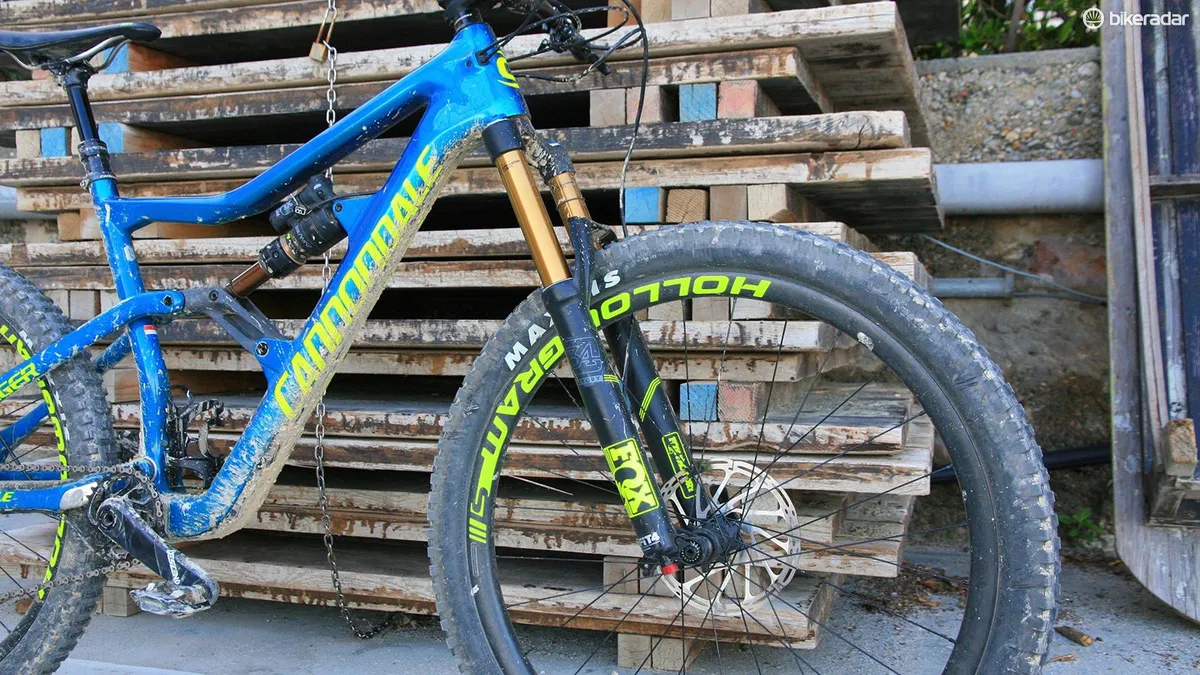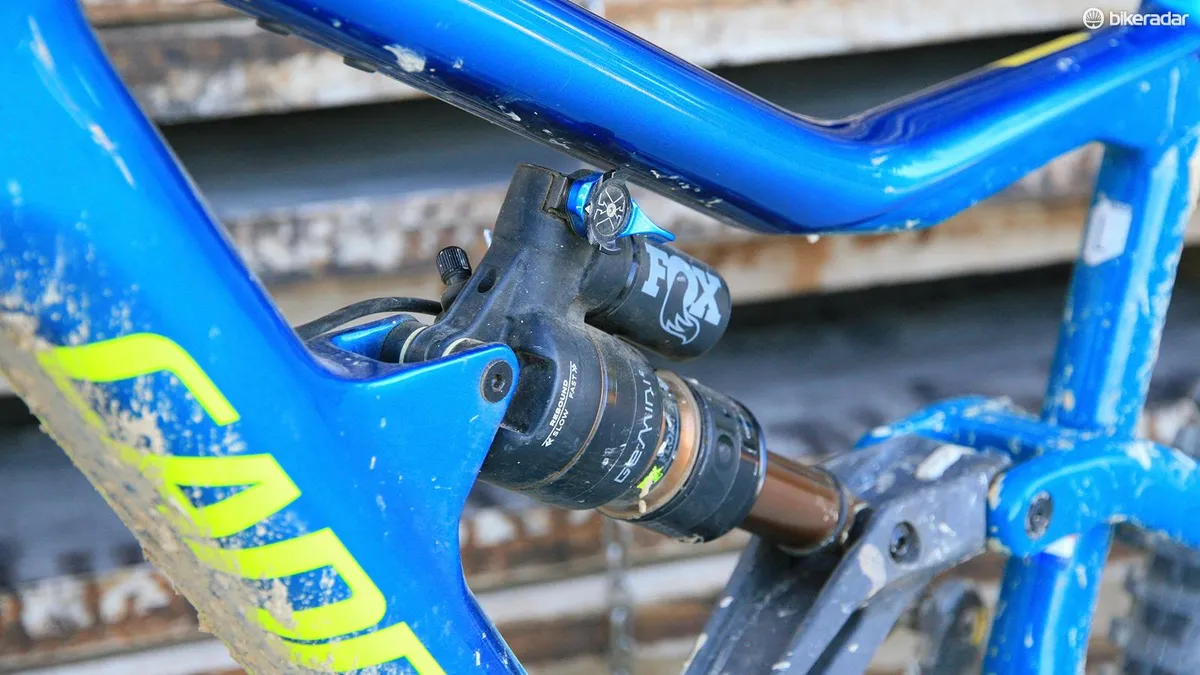The Trigger name isn’t new, but for 2018 Cannondale has a whole new Trigger platform, ditching the pull-shock and Lefty of old, and replacing it with Fox suspension front and rear.
As is Cannondale’s way, it’s not all standard stuff, with the team from Wilton, Connecticut working with Fox to create extra bells and whistles for the shock on its all day, all mountain trail bike.
This is a bike designed for those who look to earn their descents, so Cannondale has built a bike that needs to be able to shred descents while still being capable on the climbs too. Travel at the front is 150mm and the rear supplies up to 145mm of movement.
There are three Trigger models in the range, which all share a carbon front triangle and link, with the top Carbon 1 model featuring a carbon back-end while the others use an alloy version.
Cannondale Trigger kit

With the basics covered, here’s Cannondale’s special sauce — the Gemini system.
The Trigger’s rear suspension has two modes: ‘Hustle’ and ‘Flow’. Hustle mode is there for climbs and pumpy, smooth descents, whereas the ‘Flow’ mode is designed for ripping downhill.
A bar-mounted lever actuates a cam in the shock, which blocks off a portion of the Float X or DPS shock, cutting the size of the airspring. By doing this it gives a much more progressive spring rate, holding the bike higher in its travel and limiting its travel to 115mm – this is the Hustle mode.
In Hustle mode, the suspension is more stable in climbs (although the shocks also have a three-position low-speed compression lever, which can fully lock it out), and also much more reactive to being pumped through g-outs and berms, thanks to that extra progression.

In Flow mode the bike is open to its full 145mm of travel and sits further into its travel, giving the full benefit of the Float X’s performance. The lever in Flow mode keeps the full air volume of the shock open. The overall volume of the air spring can be adjusted by adding Ramp Rings to a carrier, however this is held behind the closeable bulkhead in the shock, so only the Flow mode benefits from tuning this.
Adding or removing Ramp Rings requires a specific tool and Cannondale recommends it only being done by dealers or suspension tuners.
While riding with the Cannondale team, they suggested toggling between modes on the descents, dropping the bike to Hustle mode when that extra progression would be beneficial — they don’t see them as climb/descent modes.
Cannondale Trigger frame
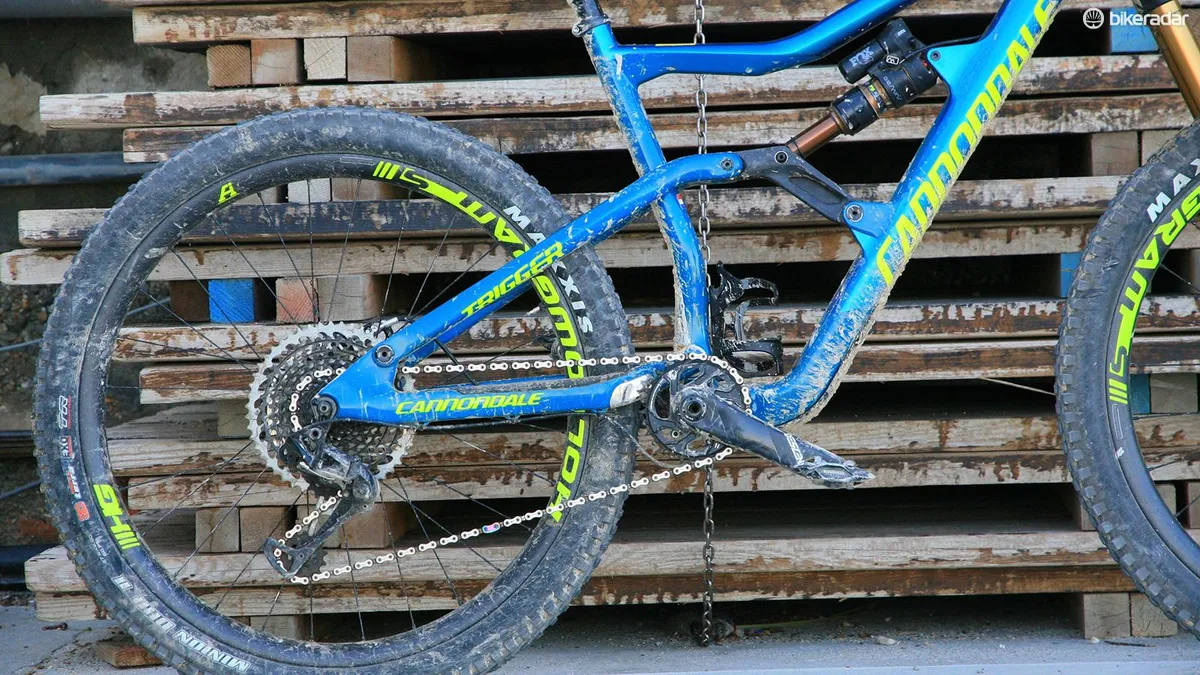
The front triangles are all made from carbon, as is the main link which drives the shock. The space above the bottom bracket has room for a reasonable-sized bottle, with Cannondale very keen to point out the compatibility. The frames are also Di2 compatible, front mech compatible and come with a tough carbon fibre downtube protector.
Cannondale has gone contemporary with the geometry on the Trigger, with a fairly slack 66-degree head angle paired with a reasonably steep 74.5-degree seat angle. A 45mm stem and wide bar keep handling snappy, while the 420mm rear stays are also suitably short. This is paired with a 459mm reach — not radical, but a solid figure for all-round trail riding. If I'm being critical, the 345mm bottom bracket height (with 12mm drop) is a little tall on paper.
The other feature only seen on Cannondales is the AI rear end — this effectively shifts the drivetrain 6mm to the right. This means mud clearance is ample and allows for better triangulation of the rim between the hub flanges, giving a stronger, stiffer build. If you’re going to use your own (boost spaced) wheels, you’ll need to re-dish them.
Cannondale Trigger pricing
Cannondale Trigger 1
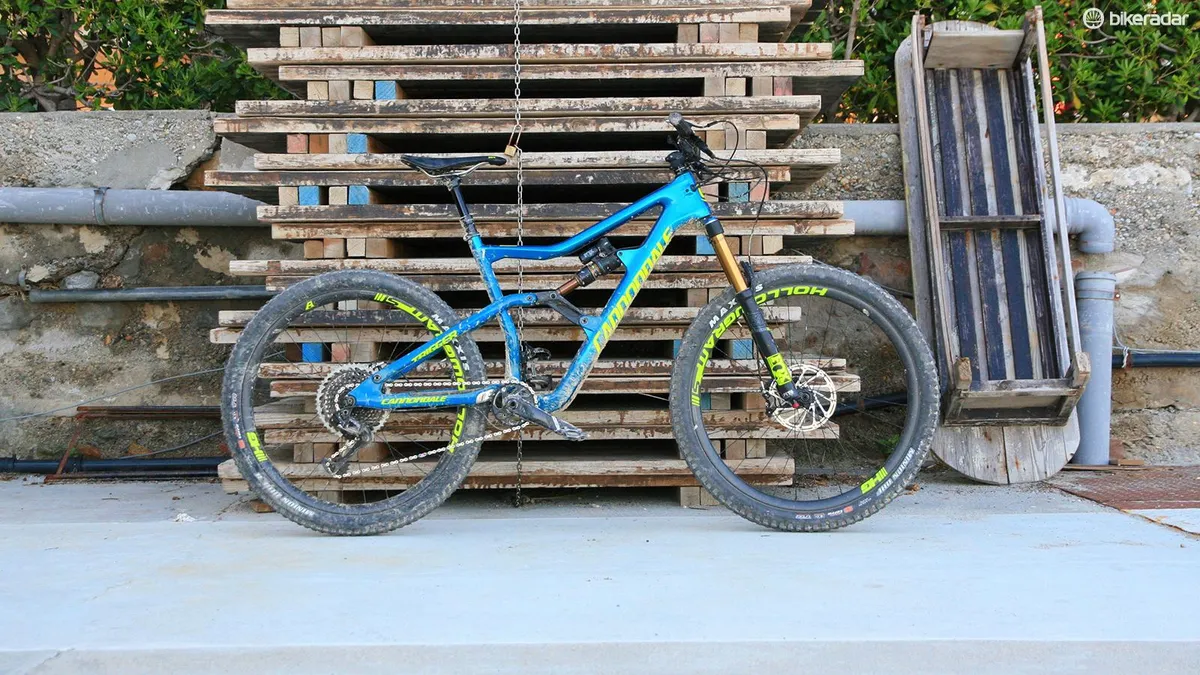
The Trigger Carbon 1 is the top-end model at £6,000 / $8,200 / AU$TBC.
As you’d expect, it comes with a top-draw spec list. There’s a Fox Factory Float 34 fork, with the Fit4 damper and Kashima coating, to go with the Float X EVOL shock, also Kashima coated. Cannondale reckons the weight penalty with the Float X is worthwhile, given the improved heat management and damping performance.
SRAM XX1/XO1 Eagle drivetrains and Guide RSC brakes make an appearance, as do Cannondale’s own carbon Hollowgram wheels with a 30mm internal width holding the Maxxis Minion DHF/DHR tyre combo.
Cannondale Trigger 2
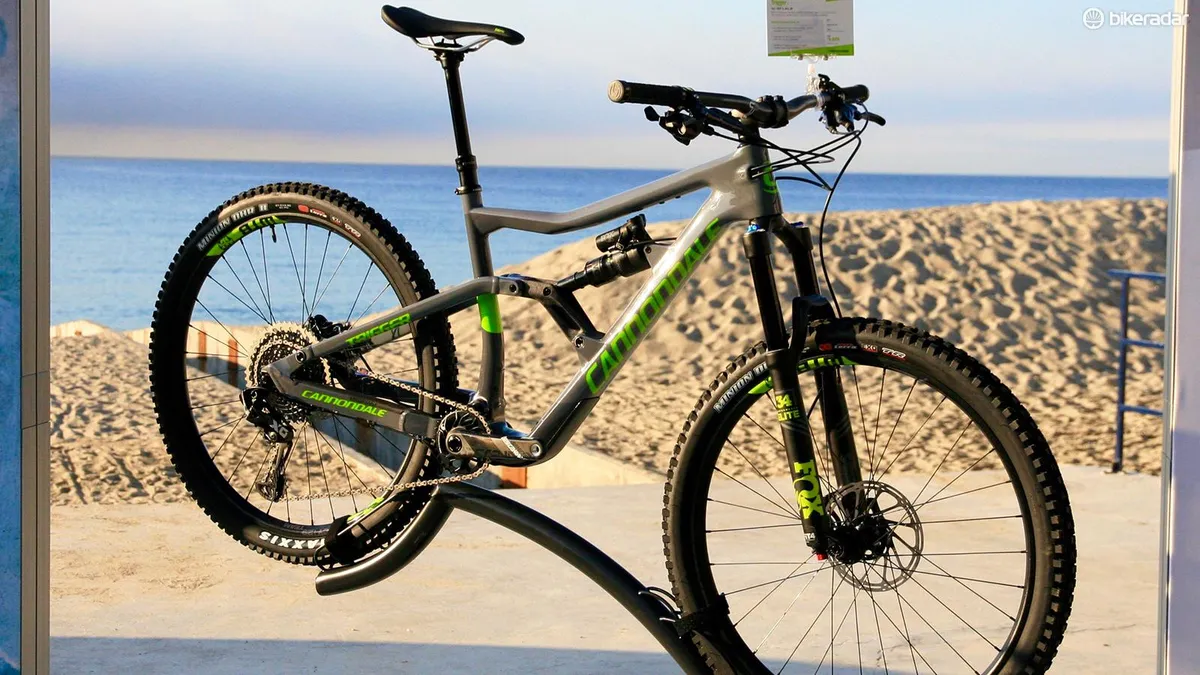
The £5,500 / $5,999.99 / AU$TBC Trigger Carbon 2 has an alloy back end and still gets a Float X shock, but this time in Performance Elite flavour. There’s a Performance Elite 34 fork, X01 Eagle groupset and Guide RS brakes while the same tyres as the Trigger 1 run on WTB Frequency Team i29 rims.
Cannondale Trigger 3
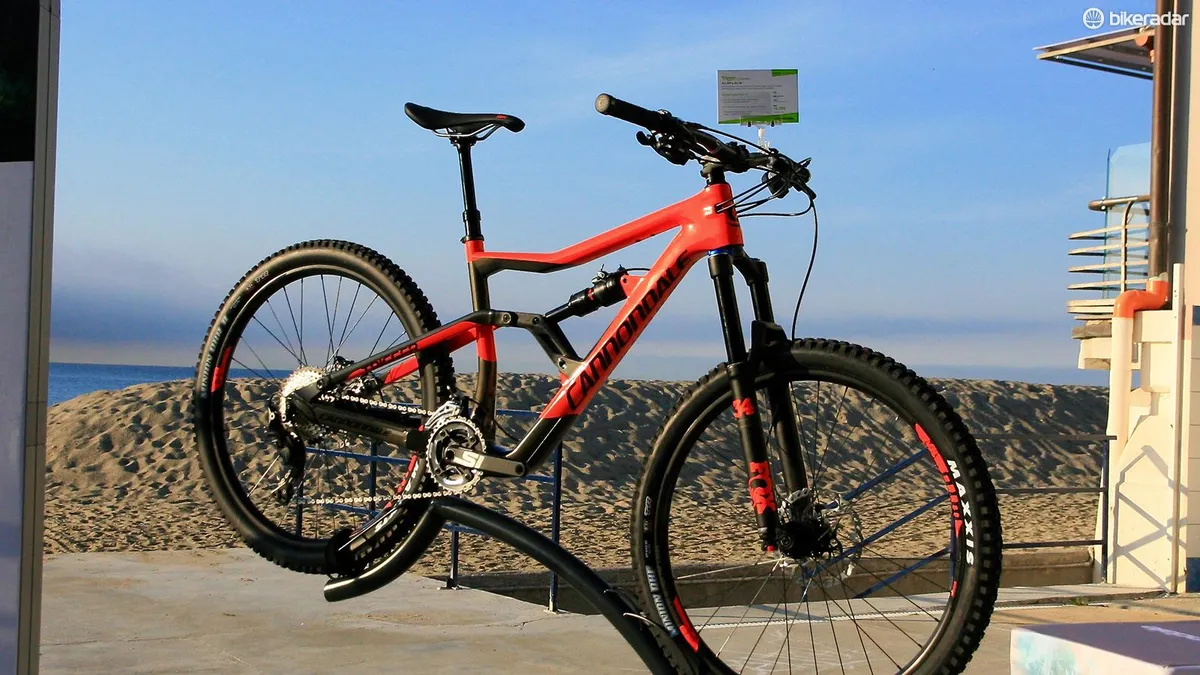
At £4,000 / $3,999 / AU$TBC the Trigger Carbon 3 is fitted with a Float Performance DPS Evol shock (no piggyback) and 34 Performance fork. The Shimano XT/SLX drivetrain is based on a 2x11 set-up and you get matching SLX brakes.
Non-triple compound Minion tyres roll on WTB Frequency Race i29 rims, while the RaceFace Turbine post is dropped in favour of the cheaper TransX 120mm dropper post.
Cannondale Trigger women's
Coming soon will be a women’s version with the same frame, but a spec-list tuned to female buyers.
Cannondale Trigger ride impression
I only had a brief ride on the Trigger during the launch, however initial impressions were good.
The Gemini system makes a noticeable difference to the way the bike rides, with a pronounced increase in the progressivity of the shock when dropping into Hustle mode.
I used this mostly on the climbs and traverses because when the trails got rowdy I wanted to benefit from the full 145mm of travel.
I’d like to spend more time on the bike though, as I felt the rear shock could do with more volume spacers being added when in Flow mode, to give that little extra support from the mid-stroke.
Geometry is pretty much spot-on for this sort of bike too, with a decent reach giving room to manoeuvre over the bike and a seat angle steep enough to make climbing less of a chore.
In rocky terrain the tall bottom bracket helps prevent pedal strikes, however I’d perhaps run the shock relatively soft once I’d added volume spacers to get it to sit deeper into its travel on steep terrain, lowering the BB for better cornering stability.
